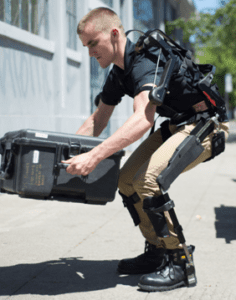Call Us Now1-800-414-2174


The future is here. If you have seen the movie, Iron Man, the title character wears an exoskeleton that enables him to become a super human. In the movie, Aliens II, the title character uses a robotic exoskeleton in an outer space industrial setting to lift heavy equipment and to fight off the queen alien! Just science fiction, right? Well, exoskeletons are now reality and are being introduced to industry for use on the job.
So, what is it and how does it work?
The exoskeleton system is an industrial wearable robotic system that is designed to minimize workers’ spinal forces, knee joint forces and shoulder joint forces on the job. Usable models are lightweight mechanical devices worn on the body that move within the user’s full range of motion.
The arm support mechanism of certain types of the exoskeletons progressively activates as the arms lift and gradually releases as the arms return to a resting position. The SuitX model which I had the opportunity to wear and use has the ability to lock and support the arms overhead to reduce muscle fatigue while performing overhead work.

The back component of the exoskeleton that I tried out also applies the same store d energy application when lifting. I attempted to lift a large box with 100 lbs of weight in it and at age 63 found the exoskeleton made the task easy to perform without any noticeable strain on my back. This same lifting task was also repeated by a young woman wearing the exoskeleton and she experienced the same results. In fact, she was unable to lift the 100 lb box at all without the exoskeleton. The stored energy system in the exoskeleton essentially provided a significant force superimposed over the body to complete the task.
The exoskeleton may provide a real boost in safety for an aging work population. Considering that people today are working well past 50 years of age and that the 65 year and older age group have doubled between the years 2000 and 2012 (BLS, 2014), it has become imperative to utilize all the ergonomic tools available to reduce injury risks with age.
Increasing Productivity with Exoskeleton Technology
In ASSE’s Safety Professional Magazine article, Exoskeleton Technology – Making Workers Safer and More Productive (Butler, 2016), an exoskeleton was studied in a real work environment and found to significantly increase productivity and quality of painting (a dynamic work task) and welding (a static work task). The exoskeleton, referred to in this article as a personal ergonomic device (PED), was found to significantly reduce worker fatigue and associated soreness.
In a study by Herberts and Kadefors, the surpraspinatus muscle (one of the 4 rotator cuff muscles) was shown to be consistently fatigued during overhead welding for prolonged periods of time. Much of this muscle fatigue was offset by the unloading of the muscle by the exoskeleton PED. The exoskeleton was found to also lower the percent maximum voluntary contract (%MVC) to perform the work tasks studies (Chase – unpublished study). It is opined that the unloading of muscle and reduction of the %MVC allowed welders and painters used in this field test to weld and paint longer and maintain a higher degree of accuracy.
The reduction in fatigue experienced by muscle when wearing and using an exoskeleton can be explained physiologically. Traction forces on a loaded muscle tendon increases impairment of capillary microcirculation. This reduces blood’s delivery of oxygen and results in a build-up of lactic acid, pain, and fatigue. By reducing the traction on a muscle tendon, the worker experiences less muscle fatigue which results in reduction of the risk of developing a MSD such as tendonitis.
Although exoskeletons will allow workers to perform at higher levels for longer periods of time with improved accuracy, thus improving productivity, employers should understand that humans will still fatigue over time without adequate rest breaks. However, combining the use exoskeletons with regular rest breaks may well change the playing field for aging workers in the very near future. With exoskeleton technology, employers can expect to benefit from improved productivity and marked reduction of injuries. A win-win for everyone.
References
Bureau of Labor Statistics (BLS). (2014, Jan. 6). Labor force participation projected to fall for people under age 55 and rise for older age groups. The Economics Daily. Retrieved from www.bls.gov/opub/ted/2014/ted_20140106.htm
Chase, B. The Levitate difference: Analysis of the Levitate personal ergonomic device (PED) during various physical work-related tasks (Unpublished white paper). San Diego, CA: Levitate Technologies.
Exoskeleton. (2016). In Encyclopedia Britannica Kids. Retrieved from http://kids.britannica .com/elementary/article-399448/exoskeleton
Herberts, P. & Kadefors, R. (1976). A study of painful shoulder in welders. Acta Orthopaedica Scandinavica, 47(4), 381-387.doi:10.3109/17453677608988705
Knight, W. (2015. July 16). The exoskeletons are coming. MIT Technology Review. Retrieved from www.technologyreview.com/news/539251/the-exoskeletons-are-coming
MacDermid, J.C., Ghobrial, M., Quirion, K.B., et al. (2007). Validation of a new test that assesses functional performance of the upper extremity and neck (FIT-HaNSA) in patients with shoulder pathology. BMX Musculoskeletal Disorders, 8(42).doi:10.1186/1471-2474-8-42
WorkSaver Employee Testing Systems 478 Corporate Dr. Houma, LA 70360
![]()